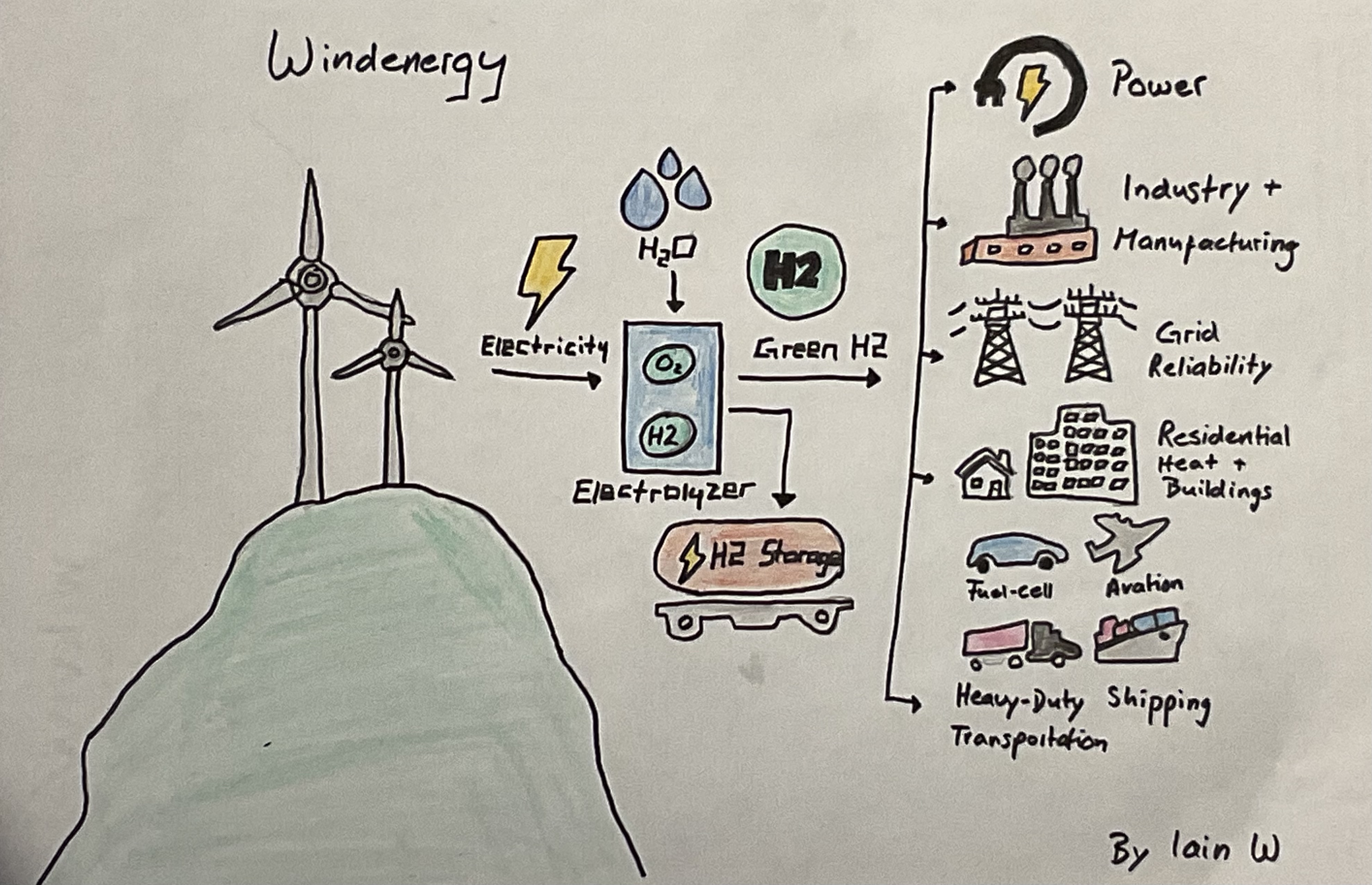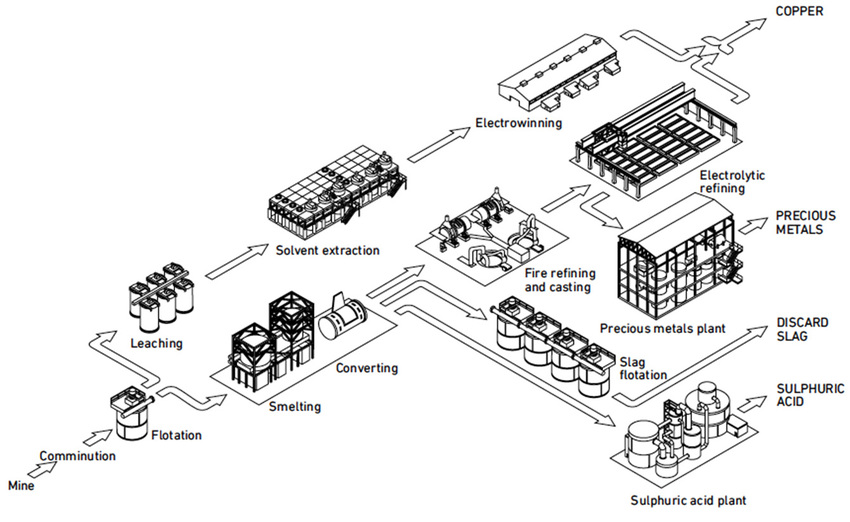Wind Energy
The process of using the wind to generate mechanical power or electricity is known as wind power or wind energy. Wind turbines transform the wind's kinetic energy into mechanical energy. This mechanical energy can be employed for specialized operations (such as grain grinding or water pumping) or transformed into electricity by a generator.

Introduction
As part of our "Interdisciplinary project work 3" we will look at the past of the use of nuclear energy, the present of the use of nuclear energy and the future of the use of nuclear energy.More...
Teaser
Hydrogen (Wasserstoff) was discovered in 1766 by Henry Cavendish, an English scientist, when he made base metals react with acids (Säuren). He called the element "phlogiston". In 1783, A. L. de Lavoisier succeeded in synthesizing the gases hydrogen and oxygen to water. Lavoisier then named hydrogen after two Greek (griechisch) terms: hydro (water) and gennao (I generate) as "hydrogene" – “I generate water”. In 1814, the element symbol "H" was introduced by Berzelius, a Swedish chemist. But how has this element changed over the years?
More...
"Stored deep under us and ready to release"
Expression
The term "geothermal energy" refers to energy stored in the subsurface in the form of heat. At a depth of about 15 meters, the surface temperature remains constant throughout the year. In Switzerland, the temperature below the surface generally increases by around 30°C for every kilometer of depth. The temperature at a depth of 5'000 metres is about 160°C. At depths greater than 1'000 meters, significant amounts of heat above 40°C can be used. This geothermal heat can be obtained using various methods.
 More...
More...

Picture of the Internet, without source.
Tiziano Di Paola
Introduction
Copper (Latin cuprum) is a chemical element with the element symbol Cu and atomic number 29. It is a transition metal, in the periodic table it is in the 4th period and the 1st subgroup (according to new counting group 11) or copper group. The Latin name cuprum is derived from (aes) cyprium "ore from the Greek island of Cyprus", where copper was mined in ancient times.
As a relatively soft metal, copper is easy to shape and tough. As an excellent conductor of heat and electricity, it has many uses. It also belongs to the group of coinage metals.
As an important technology or functional metal, copper belongs to the group of semi-precious metals.
Mining
Copper ores are often contain sulphur. Sulphuric acid can be released from mining dumps through weathering processes and washed into the surrounding area by rainwater. The groundwater is because of that in dangerous.
Processing
In the next step , sulphur is going to be seperated from copper. It ist possible that because of that the smelling of SO2 ist very strong und it can cause irritation of the mucous membranes.
Acid rain
Even far-off regions can be affected, as pollutants can be transported by the wind. In this way soil organisms are disturbed and plant communities are damaged.
Example
Copper is often used in cabels and pans. It is a good conductor of electricity. 
https://dontwastemy.energy/2017/01/20/copper/
Here you have a overview for the «6 R’s»:
More...
Florian and I have chosen the theme of transportation. Transport seems to us to be an extremely important factor for our economy.
Almost everything is transported by ship. Over nine billion tonnes of global sea freight per year can be felt not only under the sea but also on the surface: high pollutant measurements of nitrogen dioxide (NO2) in the atmosphere correlate with busy shipping routes. The volume of NO2 from ship exhaust gases is now almost equal to those caused by road traffic. Ozone levels in coastal areas are rising sharply.
Texte 18/2009: Strategie für einen nachhaltigen Güterverkehr (umweltbundesamt.de)
Exemple Germany: "Der zunehmende Güterverkehr hatte in den letzten Jahren wenig damit zu tun, dass aufgrund des Wirtschaftswachstums die Zahl oder das Gewicht der transportierten Güter angewachsen wären. Vielmehr sind andere Ursachen zu suchen. Der Güterverkehrsaufwand5 wuchs – gemessen in Tonnenkilometern (tkm) – wesentlich stärker als das Transportaufkommen. Seit 1960 hat er sich vervierfacht. Das Wachstum beschleunigte sich deutlich in den 1990er Jahren und setzte sich – bei stagnierendem Transportaufkommen – auch nach der Jahrtausendwende fort.
Grund dafür sind zunehmende Transportweiten. So stieg die mittlere Weite eines Lkw-Transportes im gewerblichen Güterverkehr zwischen 1997 und 2005 um 32% von 98 km auf 129 km pro Fahrt. Bei der Bahn stiegen die mittleren Transportweiten im selben Zeitraum um 31% von 230 km auf 301 km.

The journey of a laptop (vimeo.com)
In order for all the transportation in our world economy to run smoothly, many means of transportation are used, one is airplanes, ships, cars, trucks and so on. They make sure that the product gets from A to B without suffering any damage. Was sehr spannend an diesem ganzen ist, ist der Wasserweg. Es werden 50% des Rohöls per Tanker und ganze 80% aller Güter über Flüsse und Meere transportiert.
Vocabulary
surface = Oberfläche
shipping routes = Schifffahrtswege
pollutant measurements = Schadstoffmessungen
transportation = Transport
road traffic = Straßenverkehr
coastal areas = Küstengebiete
rising sharply = Starker Anstieg
Bild: https://www.limbiq.com/de/2020/11/11/transportmittel-vergleich/
https://www.wasserstoffostschweiz.ch/fahrzeuge/emissionen/
In 1991, Switzerland became one of the first countries in the world to implement an e-waste recycling system, in which the disposal price is paid in advance when a product is acquired. All trash electrical and electronic equipment can now be dropped off for free at collection and sales points, where it will be professionally and environmentally friendly disposed of.
Other countries have followed suit to some extent, but the United Nations Environment Programme estimates that up to 90% of the world's e-waste is illegally transferred. WEEE is increasingly being imported from developed countries, particularly to Asia and Africa, and is frequently misdeclared. More...
Embodied energy is the sum of all the energy required to produce any consumer goods or services. How much embodied energy is hidden in our day-to-day lives?
Embodied energy is the energy that is consumed in order to build a given usable object. This includes the energy from material extraction, refining (Verfeinerung), processing, transporting and fabricating. It is named as such because it is as if this energy is "embodied" within the item itself. Embodied energy also comes along with idea of embodied carbon, which is the associated (zugehörig) CO2 footprint that is emitted (ausstossen) during the objects creation.
Embodied energy is found within all types of objects, including things like cell phones, appliances (Haushaltsgeräte), homes, buildings and furniture. The embodied energy of a given object can be analyzed by knowing what materials are contained within an object, and how much of that given material there is. The amount of energy needed to produce a certain material such as aluminum, steel or concrete (Beton) is known and can be used to calculate the embodied energy within an item.
Examples of embodied energy:

Video about embodied energy:
Embodied Energy - What's that?
Our Audio Pitch:
Soil.m4a (549,72 kb)
Picture and Text Sources:
Embodied Energy 1 [energyeducation.ca]
Embodied Energy 2 [nxtgenhouses.com]
Authors:
Anabel & Sandrine

What is Hydropower Plant?
The hydropower plant or hydroelectric power plant is used to convert the kinetic energy of water into electrical energy. The kinetic energy developed in the water flow due to the gravity of falling water from higher to lower head.

The advantage of the hydropower plant:
The advantage of this power plant is that it does not require any fuel. Therefore, the running cost of this plant is very less. It only requires the water head which is available naturally. It is also renewable and sustainable.
The disadvantages of the hydropower plant:
One of the cons of hydropower is that it alters the natural conditions in the respective ecosystem.
For instance, water flows are disrupted or changed in a different direction or manner.
Through the building of dams, habitats of many animal and plant species may be destroyed. Many animals now have to relocate to other areas of land.
Further check out this explaining-video: Hydropower 101 - Bing video
Or our selfmade sway: Hydropower plant (office.com)
Or for checking your knowledge our kahoot!: Kahoot!
For any further questions, feel free to ask us!
Greets from team flirty <3
Florian & Suzana